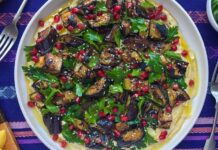There’s something deeply comforting about a bowl of warm, spiced stew—especially when it’s rich with earthy aromas, vibrant colors, and a story that spans generations.
Today, I’m bringing you a dish inspired by the bold, sun-drenched flavors of Yemen, elevated by a modern kitchen ally: RoboFood Hawaij Seasoning.
This isn’t just any spice blend—it’s a carefully balanced mix of cumin, black pepper, turmeric, and cardamom, capturing the essence of Yemeni home cooking in a single jar.
And with it, I’ve crafted a unique, plant-powered stew that’s both nourishing and deeply flavorful: Yemeni Spiced Chickpea & Spinach Stew.
Why This Stew Stands Out
This recipe is more than just a quick weeknight dinner—it’s a celebration of tradition with a modern twist.
While chickpea stews exist in many cultures, this version draws deeply from Yemeni culinary roots, using Hawaij to layer warmth and complexity without heat.
The result?
A subtly aromatic, golden-hued stew that’s hearty enough for cold evenings but light enough to serve with fresh flatbread and a squeeze of lemon.
What makes this stew special isn’t just the taste—it’s how accessible it is.
With one scoop of RoboFood Hawaij Seasoning, you bypass the need to source and blend multiple spices.
Yet, the dish still feels authentic, rich, and deeply satisfying.
Whether you’re a spice enthusiast or someone new to Middle Eastern cuisine, this stew invites you to explore a world of flavor with ease.
The Star of the Show: RoboFood Hawaij Seasoning
Hawaij (also spelled hawaij or hawayej) is a traditional Yemeni spice blend, and it comes in two main varieties: one for coffee and one for savory dishes.
The savory version—used here—is a warm, earthy blend typically made with ground cumin, black pepper, turmeric, coriander, and sometimes cardamom and cloves.
It’s essential in Yemeni soups, rice dishes, and meat preparations.
RoboFood’s Hawaij Seasoning captures this balance perfectly.
It’s not overly spicy, but deeply fragrant, with a golden warmth from turmeric and a grounded depth from cumin.
I’ve tested several homemade versions, but RoboFood’s blend stands out for its consistency, freshness, and authentic flavor profile.
Plus, its fine grind ensures it blends seamlessly into sauces and stews without leaving gritty bits.
The Recipe: How to Make Yemeni Spiced Chickpea & Spinach Stew
This one-pot wonder comes together in about 40 minutes and requires minimal prep.
It’s vegan, gluten-free, and loaded with plant-based protein and fiber.
The key is letting the spices bloom in oil first—this unlocks their essential oils and deepens the flavor of the entire dish.
Ingredients You’ll Need
- 2 tablespoons olive oil
- 1 large yellow onion, finely diced
- 3 garlic cloves, minced
- 1 tablespoon fresh ginger, grated
- 2 teaspoons RoboFood Hawaij Seasoning (adjust to taste)
- 1 teaspoon smoked paprika (optional, for depth)
- 1 can (15 oz) diced tomatoes
- 2 cans (15 oz each) chickpeas, drained and rinsed
- 4 cups vegetable broth (low sodium preferred)
- 5 oz fresh spinach (about 5 loosely packed cups)
- 1 tablespoon lemon juice
- Salt to taste
- Optional garnishes: crumbled feta, cilantro, lemon zest, or a drizzle of tahini
Step-by-Step Instructions
- Sauté the Aromatics: In a large pot or Dutch oven, heat the olive oil over medium heat. Add the diced onion and cook for 5–7 minutes, stirring occasionally, until soft and golden at the edges.
- Add Garlic and Ginger: Stir in the minced garlic and grated ginger. Cook for 1 minute, just until fragrant—be careful not to let them burn.
- Bloom the Spices: This is where the magic begins. Add the RoboFood Hawaij Seasoning and smoked paprika (if using). Stir constantly for 30–60 seconds to toast the spices. You’ll notice the aroma become deep and toasty—this step is crucial for flavor development.
- Add Tomatoes and Chickpeas: Pour in the diced tomatoes (with juice) and stir to combine. Add the chickpeas and mix well so the spices coat the beans evenly.
- Pour in the Broth: Add the vegetable broth and bring the mixture to a gentle simmer. Reduce heat to low, cover, and let cook for 20–25 minutes. This allows the flavors to meld and the stew to thicken slightly.
- Wilt in the Spinach: Stir in the fresh spinach in batches until fully wilted. Spinach cooks quickly, so this should take no more than 2–3 minutes.
- Season and Finish: Remove from heat. Stir in lemon juice and taste for seasoning. Add salt if needed—remember, broth can vary in saltiness. For extra brightness, add a bit more lemon juice.
Serving Suggestions
This stew shines when served with:
- Fresh flatbread: Warm pita, naan, or Yemeni malooga bread is perfect for dipping.
- Bulgur or rice: Try it over a bed of fluffy basmati rice or cracked bulgur for a heartier meal.
- Yogurt or labneh: A dollop cools the warmth of the spices and adds creaminess.
- Lemon wedges: Always serve with extra lemon on the side—its citrus cuts through the earthiness beautifully.
Tips for Perfecting the Dish
To make this stew truly shine, keep these tips in mind:
- Bloom the spices wisely: Don’t rush the spice-toasting step. Let the Hawaij sizzle just enough to release its oils, but don’t let it burn. Lower the heat if needed.
- Use good-quality broth: Since this is a plant-based dish, the broth plays a big role in flavor. Opt for a rich, savory vegetable stock.
- Add greens flexibility: While spinach is traditional here, you can swap in kale, Swiss chard, or collard greens. Just adjust cooking time—kale takes a few extra minutes to soften.
- Make it ahead: This stew tastes even better the next day! Store it in the fridge for up to 4 days or freeze for up to 3 months.
- Boost the protein: For a non-vegan version, stir in shredded chicken or ground lamb during the last 10 minutes of cooking.
Why Hawaij Is a Game-Changer for Home Cooks
Spice blends can transform simple ingredients into something extraordinary, and Hawaij is no exception.
Unlike generic ‘curry powder’ or ‘taco seasoning,’ it has a distinct personality—warm but not spicy, earthy but not heavy.
It pairs beautifully with legumes, grains, and vegetables, making it a secret weapon for weeknight meals.
RoboFood’s version stands out because it’s free from fillers, anti-caking agents, or artificial flavors.
It’s just pure, ground spices—consistent, potent, and shelf-stable.
Once you try it, you’ll find yourself reaching for it not just in stews, but in scrambled eggs, roasted vegetables, soups, and even salad dressings.
Nutritional Benefits of This Stew
Fuel your body while delighting your taste buds.
This stew is packed with plant-based nutrition:
- Chickpeas: High in protein and fiber, they support gut health and help you stay full longer.
- Spinach: Loaded with iron, vitamin K, and antioxidants—plus it wilts in without adding bulk.
- Turmeric (in Hawaij): Contains curcumin, known for its anti-inflammatory properties.
- Olive oil: A heart-healthy fat that helps absorb fat-soluble vitamins from the veggies.
This dish is low in saturated fat, cholesterol-free, and naturally gluten-free—ideal for anyone managing dietary restrictions or simply eating cleaner.
Cultural Connection and Modern Adaptation
Yemeni cuisine doesn’t get as much global attention as other Middle Eastern cuisines, but its flavors are powerful and deeply rooted.
Hawaij is more than a seasoning—it’s a cultural marker, often passed down through families with slight variations.
Some versions include coriander; others emphasize cardamom or cloves.
By using RoboFood Hawaij Seasoning, we honor that tradition while making it accessible.
This recipe isn’t claiming to be ‘authentic’—it’s a modern interpretation, inspired by and respectful of the original.
I’ve adapted it to suit contemporary pantries and dietary preferences (like plant-based eating), without sacrificing soul.
Final Thoughts: Comfort in a Bowl
In a world of fast food and flavor fatigue, dishes like this remind us of the power of simple, well-seasoned ingredients.
The Yemeni Spiced Chickpea & Spinach Stew is warming, aromatic, and deeply satisfying—perfect for rainy nights, lazy weekends, or when you just need a hug in food form.
RoboFood Hawaij Seasoning is the golden thread that ties it all together, offering a passport to Yemeni flavor with every spoonful.
Once you try it, I’m confident this will become a staple in your recipe rotation—just like it has in mine.
So grab your pot, heat the oil, and let the spices bloom.
Your kitchen is about to smell like a bustling Middle Eastern souk—and your dinner, like a home-cooked masterpiece.










